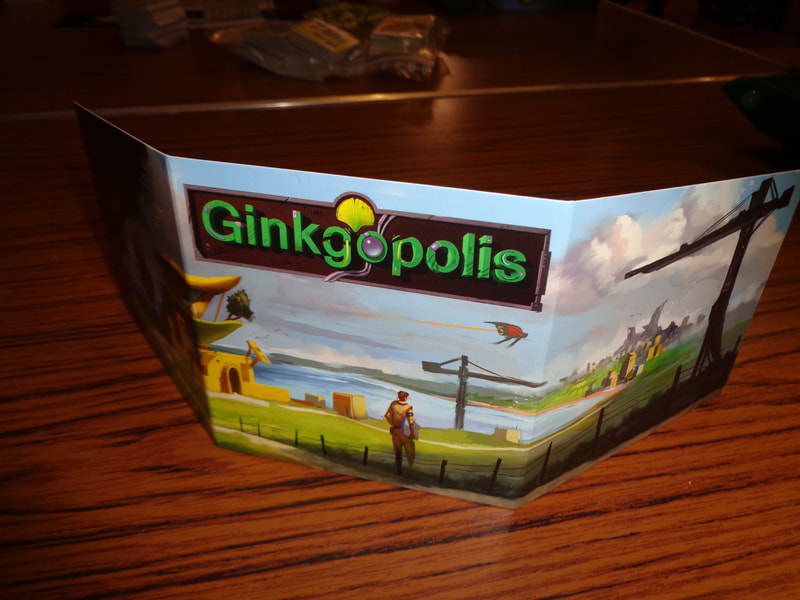|
15th January 2022 It's Wogglecon and the final game of the day was Ginkgopolis. What's a Ginkgopolis? Good question, I guess it means Ginkgo city but what does Ginkgo mean? It's a type of tree, so Ginkgopolis must mean tree-city. In Ginkgopolis, players take on the role city planners in tree-city and attempt to manage it's expansion, both outwards and upwards. What's in a game?
Ginkgopolis has solid components, the tiles and tokens are constructed from suitability thick, chunky card as are the screens, while the meeples and resources are wooden which is always appreciated. The game makes good use of colour, effectively mixing primary colours with green and emphasising the ginkgo tree motif employed throughout. Ginkgopolis' artwork is high quality, character cards are well illustrated with slightly cartoonish, colourful individuals that follow the game's red-yellow-blue and green theme, the same is true of the building cards/tiles which depict various different types of structures. The iconography in Ginkgopolis is a bit strange, there's not too much of it and it's fairly simple to understand. However, due to Ginkgopolis' almost counter-intuitive rules, getting to grips with it took a little time. Nothing too bad though. How's it play? Setup
In the basic flow of actions in Ginkgopolis, players simultaneously put down cards and then resolve them in turn order.
There are 2 ways in which Ginkgopolis can end. If the building tile supply is depleted a second time or if a player has put all resource tokens on to the city. In either case, the current round is resolved and the game goes to scoring. VPs come from various sources in Ginkgopolis.
Points are tallied, highest score wins. Overall
Firstly, one small fascinating thing about Ginkgopolis is how the game almost operates like a machine! Cards played to build something must not be put into the discard pile, otherwise they'll end up going back into circulation and later, players will end with cards in their hands that can't be used to either get currencies or build upwards. Further to this, new buildings must be given a meeple so that players can track which new cards must be added to the building deck as again, it would leave players without cards to gain currencies or build. Get this wrong and like a machine losing cogs, the game will begin grinding to a halt! I don't know what kind of fevered imagination dreamt up this mechanic but it's both convoluted and brilliant! Ginkgopolis' rules are definitely a little counter-intuitive. For example; when you play a card, that's not what you're building but what you're building on top of. Or after building something, getting to keep the card you used to build something. Additionally; it took a little bit for me to wrap my head around the game. Remember: Playing a card without a tile earns currencies. Playing a card with a tile allows a player to build a tile. I would also say Ginkgopolis is little fiddly for beginning player but none of this a dealbreaker, it's more an indicator of how Ginkgopolis feels a little unusual compared to other games I've played and I don't consider this a bad thing. While there are various avenues to follow for scoring, I feel that the biggest source of VPs would come from controlling districts because it's possible to not only score your own resources but those of other players' too! It can be quite hard to plan ahead though due to the card drafting and they'll be times when you'll want to play more than 1 card from your hand. It pushes you to make hard decisions (And hope the other cards come back around.), it means you have to adapt and spot situations you can exploit. It also means watching your neighbours and trying to gauge their objectives. There's quite a lot of player interaction that goes on and putting the right tile into play at the right time can dramatically alter the landscape. There's also an interesting strategy when deciding which tiles to put in the city. Putting a 20-value tile down makes it harder for other players to build over it, they'd have to pay VPs to build a lowered valued tile, or an extra resource to play a 20-value tile in a different colour. On the other hand, keeping a 20-value tile back can give a player the opportunity to build over other higher value tiles later in the game. The building outwards or upwards mechanics provide plenty of scope here. Expanding outwards can be easier (Provided a player gets the right urbanisation cards.) because a player need less resources and will also earn currencies when doing so. The downside is that it's easier for other players to build over your tiles. The opposite is also sort of true, building upwards tends to be costly, but it's also more costly for other players to build over them. Building tiles also puts the related card (And it's bonus action.) in to play in the player's personal area, creating the opportunity to combo actions into bonuses. Players will need to balance the need to acquire currencies with the need to build tiles. However, as the city landscape and a player hand changes, so can the options to do either of these. Adaptation is vital and every decision can be critical This made my choices feel meaningful when playing Ginkgopolis, which is always good. I'd say that Ginkgopolis is a mid-weight tile laying game with some fairly interactive area-control gameplay that gives players interesting and changing options. It took a little time to warm to Ginkgopolis but I enjoyed the game and think it's worth giving a try.
0 Comments
Leave a Reply. |
AuthorI play, I paint. Archives
March 2024
Categories
All
|









 RSS Feed
RSS Feed
